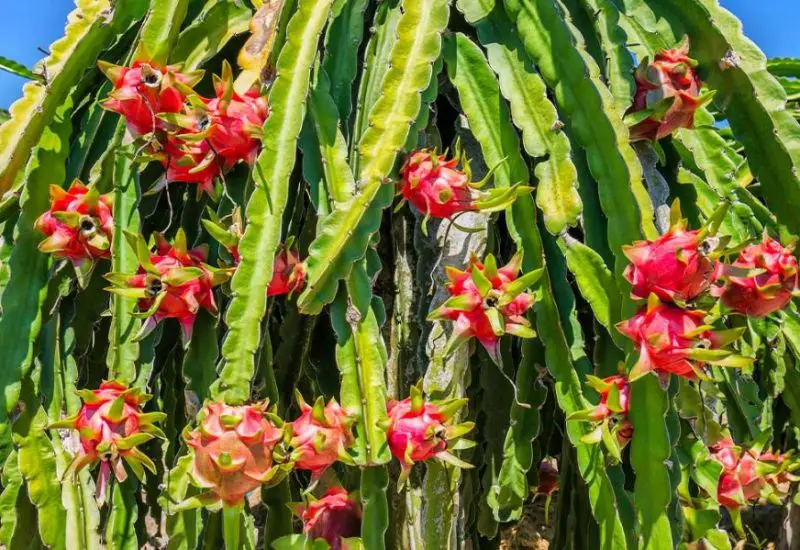The dragon fruit cactus (Hylocereus undatus), also known as pitahaya, is a striking and unusual plant native to Mexico, Central America, and South America. Its bright pink skin, adorned with thorn-like fins, and its sweet, vibrant flesh make it a prized fruit in many gardens. But beyond its delicious fruit, the dragon fruit cactus is also valued for its ornamental appeal, fast growth, and ability to thrive in tropical and subtropical climates.
In this comprehensive guide, we will dive deep into everything you need to know about dragon fruit cactus care and growing techniques.
Dragon Fruit Cactus Overview
Common Names: Dragon fruit, Pitahaya, Strawberry Pear, Moonlight Cactus
Botanical Name: Hylocereus undatus
Family: Cactaceae
Plant Type: Perennial fruit-bearing cactus
Size: 8-20 feet tall, 3-10 feet wide
Sun Exposure: Full sun, partial shade
Soil: Sandy, well-drained
USDA Hardiness Zones: 10-12
Native Region: Mexico, Central America, and South America
Dragon fruit cacti are large, sprawling plants that can grow up to 20 feet tall. Their long stems and aerial roots allow them to cling to structures, making them a natural climber in gardens or outdoor landscapes. Smaller varieties are suitable for growing indoors in containers.
How to Plant Dragon Fruit Cactus

When to Plant
The best time to plant dragon fruit cactus is in early spring, when temperatures start to rise. The growing season typically spans from March to August, giving the plant ample time to establish itself before the fall.
Selecting a Planting Site
Dragon fruit cacti need well-drained soil and thrive in full sunlight, though they can tolerate partial shade. Choose a planting location that receives ample sunlight for at least six hours a day, but in hot regions where temperatures regularly reach 100°F, partial shade can help protect the cactus from sunburn.
Ensure there’s enough space for this large cactus to spread its roots and branches. Avoid planting it near structures like buildings, trees, or electrical lines, as it needs room to grow without interference.
Spacing, Depth, and Support
Plant each dragon fruit cactus at least 6 feet apart, providing room for airflow and growth. Dig a hole about three times the depth and width of the nursery container to loosen the soil for root development. After planting, you will need to support the cactus with a sturdy trellis or other climbing structure, as the plant’s heavy stems require proper support to grow upright.
Dragon Fruit Cactus Care
Light
While dragon fruit cacti prefer warm weather and sunlight, too much direct sun can cause stem damage, especially in dry or extremely hot areas. In regions with temperatures exceeding 100°F, partial shade can help protect the plant from intense sun exposure. Conversely, too little sun can reduce fruit production, so finding the right balance is essential.
Soil
Dragon fruit cacti are not picky about soil pH, but they do require sandy, well-drained soil that retains moisture but does not become waterlogged. In drier regions, mulching around the base of the plant can help retain moisture. The plant thrives in soil rich in organic matter, so adding compost is beneficial.
Watering
Dragon fruit cacti have some drought tolerance, but regular watering is necessary for fruit production. During the growing season, keep the soil consistently moist but not soggy. Overwatering can lead to root rot and fungal diseases. In winter, reduce watering as the plant enters dormancy.
Temperature and Humidity
As a tropical plant, the dragon fruit cactus thrives in temperatures between 65°F and 80°F. It does not tolerate frost or freezing temperatures, so if you live in a cooler climate, grow the plant in containers that can be brought indoors during cold months.
Fertilizing
Dragon fruit cacti are heavy feeders. In the first year, apply a balanced fertilizer (such as 20-20-20) every two months. Once the plant is established, reduce fertilization to twice a year, in the spring and summer. Incorporating organic compost into the soil also encourages healthy growth.
Pollination
Pollination can be a challenge for dragon fruit cacti, as their large, fragrant flowers bloom only at night, attracting nocturnal pollinators like bats and moths. Some varieties are self-pollinating, while others are self-incompatible and require cross-pollination between different varieties. If your plant needs manual pollination, collect pollen from one flower and transfer it to another using a cotton swab. This should be done between dusk and dawn when the flowers are open.
Types of Dragon Fruit Cactus
Several varieties of dragon fruit cactus offer unique colors and flavors. Some of the most popular include:
- American Beauty: This variety has magenta-colored flesh and is self-fertile, making it easy for home growers.
- Dark Star: Known for its dark pink skin and purple flesh, it has a grape-like flavor but requires cross-pollination.
- David Bowie: A self-fertile cultivar with white flesh and a lemony taste.
- Purple Haze: This hybrid produces large fruits with sweet, purple flesh.
- Zamorano: A slower-growing variety with dark red flesh, ideal for container gardening.
Pruning and Maintenance
Regular pruning is essential to keep your dragon fruit cactus healthy and productive. Prune dead or damaged stems, as well as any tangled or overly long branches. Proper pruning encourages air circulation, reduces the risk of fungal infections, and promotes flowering.
Plan to prune two to three times a year, especially after harvesting, to maintain a manageable size and prevent the plant from becoming too heavy for its support structure.
Harvesting Dragon Fruit
Dragon fruit is ready for harvest when the flaps on its skin begin to wither, and the fruit can be easily twisted off the stem. Timing is crucial—fruit that falls on its own is often overripe. Properly harvested dragon fruit can be stored in the refrigerator for up to two weeks.
The flowers of the dragon fruit cactus are also edible and highly fragrant, though they bloom only at night. You can enjoy their beauty and scent in the evening or pick them for use in teas or other culinary creations.
Growing Dragon Fruit Cactus in Containers
For those with limited space or in cooler climates, growing dragon fruit cacti in containers is a great option. Choose a smaller variety, such as ‘Edgar’s Baby’ or ‘Yellow Dragon Fruit,’ and use a 5-gallon container with good drainage. Make sure to provide a sturdy trellis for the cactus to climb, and use nutrient-rich potting soil. Container-grown plants may require more frequent watering and fertilization due to the limited soil volume.
Common Pests and Diseases
Dragon fruit cacti are generally hardy, but they can attract pests like ants, mealybugs, and mites. Raccoons, birds, and other animals may also be drawn to the fruit. For disease prevention, avoid overwatering and ensure good airflow around the plant. Fungal infections, such as stem rot or cankers, may occur if the plant is kept too moist. Treat infections with fungicides and remove affected parts promptly.
Propagation
The easiest way to propagate dragon fruit cactus is through stem cuttings. Here’s how:
- Take a 10-12 inch cutting from a healthy stem.
- Allow the cutting to dry and callous for 7-10 days in a shaded area.
- Dust the cut end with rooting hormone and plant it in well-draining soil.
- Water lightly and keep the soil moist until roots develop, which usually takes 4-6 months.
Once rooted, the cutting can be planted in the garden or a larger container. With proper care, the new plant may bear fruit within one to three years.
Conclusion
Caring for a dragon fruit cactus is both rewarding and manageable with the right knowledge. From selecting the proper site and providing support to mastering watering and pruning, this stunning cactus can thrive in your garden or as a container plant. Follow this guide to enjoy the unique beauty and delicious fruits of the dragon fruit cactus, and experience the satisfaction of growing this extraordinary plant right in your backyard.






